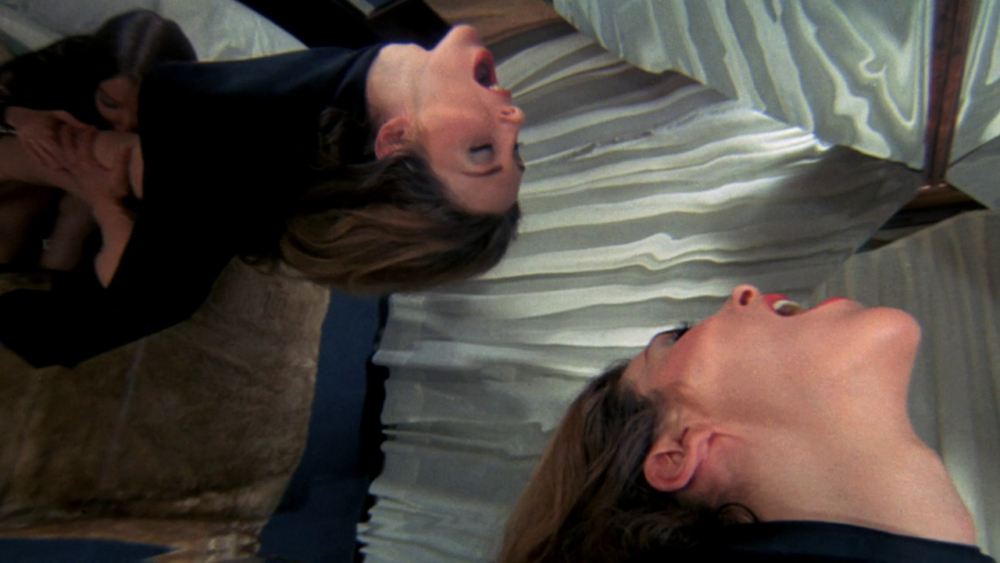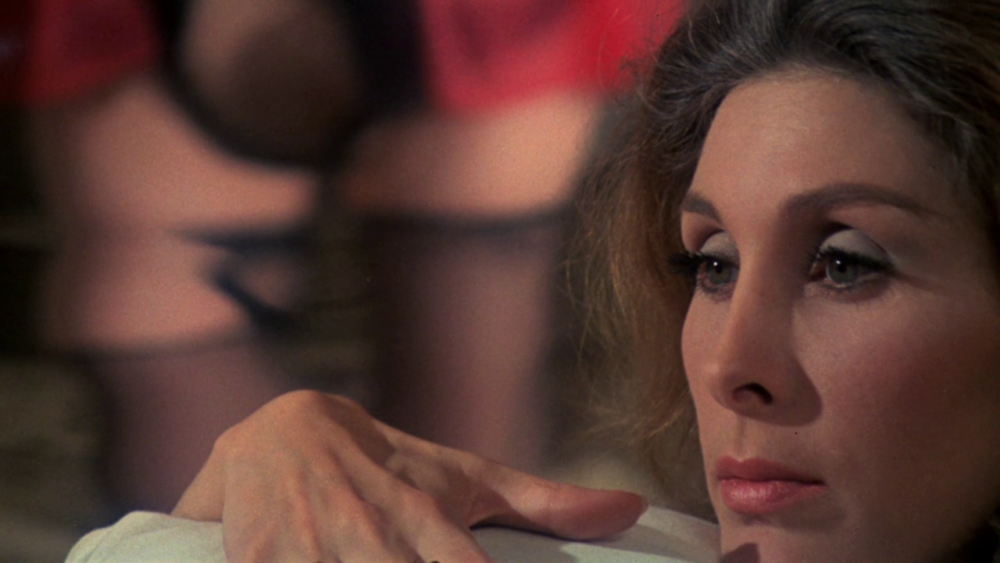
The 1974 film Score, Radley Metzger’s giddiest contribution to the porn chic era, offers audiences an enthralling queer utopia. Smack in the middle of Metzger’s career, Score signaled the end of the filmmaker’s softcore period–prefaced by works like Thérèse and Isabelle, Camille 2000, and The Lickerish Quartet. Adapted from Jerry Douglas’ all-nude stage play of the same name (though it was also known as No One’s Afraid of Virginia Woolf!), Score offered porn viewers something between the sexploitation norm of the era and the hardcore thrills that would come soon after: an alternative lifestyle that made an appealing case for bisexuality and polyamory as the gold standard.
Opening on a gorgeous foreign landscape, Score establishes itself as something queer from the get-go. The narrator, voiced by film editor Doris Toumarkine, explains:
Once upon a future time, in the lush little land of plenty, in the enviable state of affluence, bordering on decadence to the north, and the state of euphoria to the south, there nestled deep within the erogenous zone, the peaceful city of leisure, resting snugly on the western shore of the idle sea. In this lazy but lovely town, the people of leisure labored and lived and laughed and loved, and loved some more, though their love had nothing to do with the archaic notion of romantic love, which was the subject of many a cautionary tale told by the wary citizens.
This is not a film that takes place in any real dimension, but a queer niche of sexual awakening. It firmly establishes that the heterosexual norm of romantic monogamy as a concept to be rejected. From there, the film launches into its contained narrative, reinforcing the opening’s sentiment.
Score is simple in its structure, working comfortably on this island of plenty within the three-tier home of Jack and Elvira (Gerald Grand and Claire Wilbur) to set up a sex comedy that doubles as a pornographic film. As the play’s alternate title implies, the film is an amusing retooling of Edward Albee’s Who’s Afraid of Virginia Woolf? In this case, Jack and Elvira have a long-standing competition in their open marriage which involves seducing outside parties for points. With same-sex pairings being worth double, and Elvira growing bored of the ease of placing ads for sex, the couple focuses their latest efforts of courtship on the naive, just-married duo of Eddie and Betsy (Calvin Culver and Lynn Lowry).
Polyamory and bisexuality fall comfortably under the umbrella that is queer. Radley Metzger, a filmmaker who created erotic art for the target heterosexual male audience, doesn’t shy away from everything with which it comes. Linda Williams writes that he “simply takes a special delight in confounding sexual role playing” and Score exemplifies that by splitting the couples up constantly and placing them at odds with each other (140). Heterosexual assumptions of queer relationships often focus on who in the relationship is the man and who is the woman, and the film plays to that simple idea by having the older, experienced couple as the dominant figures throughout. This extends further when both Eddie and Betsy explicitly state things they wished they’d become—a cowboy and a model—and Jack offers them the opportunity to dress up as those figures. Jack and Elvira, playing along, choose to dress as a sailor and a nun respectively.
A possible interpretation of Jack and Elvira’s behavior is that of the predatory gay (queer) trope abundant in the decades prior to Score’s creation. Over the length of the film, their effort to seduce the younger couple is purely self-centered and aided by the use of drugs like alcohol, marijuana and amyl nitrate to loosen their inhibitions. Even something as innocuous as dress-up only comes into play due to Elvira taking advantage of Betsy’s past experience with being raised by nuns and Jack focusing on the type of masculinity that Eddie finds appealing. On the other hand, Jack and Elvira aren’t overtly malicious. Rather, their efforts play as beneficial to the younger couple. It’s through their guidance that Eddie and Betsy explore a new sexuality and recognize the arrangement as a sexual experience akin to their preferred tastes.
This gradual realization is illustrated by the careful interplay of narrative and visuals like cinematographer Frano Vodopivec’s subtle framing the characters and, more importantly, their bodies in various states of undress. In the aforementioned dress-up scene, for instance, the nudity is mundane. It’s casual and unfetishized because neither Eddie nor Betsy has taken to seeing the bodies of Jack and Elvira as something to be fetishized. The camerawork is as clueless as the characters themselves when necessary.

There are small hints throughout that lead viewers to question the heterosexuality of Eddie and Betsy. Betsy is the primary figure for sexual coming-of-age. This is illustrated the moment she is faced with a chance to indulge in voyeurism. She watches as Elvira and Mike (Carl Parker), the phone repairman, engage in the film’s preliminary sex act. A railing partially obstructs both the shot and Betsy’s vantage point as voyeur. With a Polaroid camera quite literally in-hand, she watches uncomfortably. The camera moves idly left to right, switching between the couple’s throes of passion and Betsy’s face. She paces as the camera does, until she snaps a photo and the flash goes off. The flash at the moment of climax is a literal reference to Betsy’s sexual enlightenment, the first sign of Betsy’s arousal in a different sort of sexuality from which she (and the viewer) is accustomed: non-monogamy and hedonism.
“In many stag films and hard-core pornos the ‘lesbian’ number is presented, as it is here, as a warm-up or rehearsal for a ‘better,’ more satisfying, number that will follow” (Williams 140). Score eschews the typical girl-on-girl sex scene early on in lieu of a heterosexual number, leading to the climactic dual sex scene: Betsy and Elvira on the second floor of the house with Eddie and Jack in the den. That climactic scene is only successful because of the prefacing build-up with these characters interacting. Betsy confesses to Elvira that she caught her husband masturbating after rejecting her sexual advances as she peeps through the bathroom door—another instance of her voyeurism. The camera also often frames Betsy alongside a mirror, reflecting her image for the viewer and, ultimately, for herself. In one swift movement, later in the game, she not only attains her dreams of becoming a model through accepting her sexuality, but she becomes both the voyeur and the exhibitionist, a queer situation by any standard.
This also extends to her dominance and Eddie’s submission throughout the evening. Betsy consistently finds herself at odds with her husband, particularly in the “dress-up” scene in which she yells at him and insults him until he removes his pants and showcases his naked body to those in the room. The few times she relinquishes that dominance is when she’s being nurtured by Elvira, like in the moments after her confession about her husband. Instead of shooting the women straight-on, Metzger shoots their reflection from a glass table as Elvira leans in, rubs her back, and nearly kisses her. It is yet another example of true desires being reflected instead of presented forwardly for Betsy.
Eddie proves an entirely different situation. His hesitation at engaging with Jack in a sexual manner mirrors Betsy’s reluctance, but his cluelessness at Jack’s advances extends further. Early on, Eddie seems dismissive of homosexuality even though he’s clearly disinterested in his wife. In one conversation, Jack compliments Eddie’s ring and when Eddie explains he was unsure whether he liked it because it looked queer. Jack asks, “Queer strange or queer faggoty?” Eddie replies with the latter. As he doesn’t identify as a queer individual, he resents the notion of his ring being considered “queer faggoty” and doesn’t readily identify anything Jack does as queer. It isn’t until he’s downstairs in the den that the lines begin to blur for him. “Ever look at the others?” Jack asks, switching out the straight porn magazine for an all-male one. “Yeah, once,” Eddie replies.
Metzger intercuts this scene with Betsy telling Elvira that she once found dirty magazines with naked men. This cuts back to Jack inquiring, “Well, have you ever been to bed with a man before?” to which Eddie answers, “No. Not since I was fifteen. Y’know, a little mutual messing around.” The camera snaps to Jack slapping his hand on Eddie’s thigh suggestively and the gesture still doesn’t register.

The ensuing conversation between Jack and Eddie is just as interestingly framed as those between Betsy and Elvira. When Eddie explains his youthful sexual experiences, the viewer only sees his shadows against the wall. This transitions into the turning point for Eddie, in which Jack proposes to show him some home movies he’s created. Rather than present this conversation through faces, the camera is positioned at the hips of the men, presenting trail of fur leading into Jack’s pants and the bulge in Eddie’s jeans as the dialogue happens. It’s a loaded shot that soon leads into Eddie allowing the projection of Jack’s 8mm porn film onto his abs first, and later onto his white pants.
Where Betsy’s experience is all about reflection, Eddie’s experience is all about the imaginary becoming reality. The porn magazines he’d once looked at become the gay porn movies being projected onto Jack’s bulge. In the 8mm film, a man pulls down a jockstrap to reveal a semi-erect penis where Jack’s penis itself would be. Eddie stares intently and then looks up at Jack whispering, “Wild, pretty wild.” In the next scene, as Eddie continues flipping through the gay porn magazines once the short is done, Jack reveals himself to Eddie under the guise of “sleeping in the raw”. Eddie then finally expresses his submissive nature—“You’re the boss”—before giving into temptation.
Although this is a porn film, Metzger doesn’t dive right into the sex for either one of his two climatic scenes. He suggests plenty with phallic imagery, such as Jack grabbing Eddie’s belt as though it was an erect penis, stroking it, and rubbing it against his face, as well as grabbing the extended tip of the bandana to pull him closer. But the most telling moment in the entire film as to Eddie’s tastes comes as he is being penetrated anally by Jack. Attempting to mirror his intoxicated state of mind, Metzger cuts between Eddie being penetrated by Jack to being penetrated by Betsy. This shifts back and forth until, inevitably, he settles on laying in bed with Jack, with the camera positioned on his hand wrapped lovingly around his back.
The film’s thesis comes together in the morning after the sexual indulgences as Betsy and Eddie both discuss what they did and come to terms with the fact that they’re not as heterosexual as they once thought. They both reluctantly admit their indiscretions in what Jack refers to as “a bad case of the morning after.” Metzger brings Mike back into the scene, with the reveal that he is as gleefully interested in Jack as he was in Elvira. Here, Mike lifts Betsy up onto a metaphorical pedestal, one upon which she—as sexually enlightened as Jack and Elvira—may look down upon the hesitant Eddie. He presumes to leave, but Betsy hijacks the sexual situation they’ve all been placed in and finds common ground for Mike and Eddie to bond. With her in the center of these two men, as a conduit for attraction, Eddie finds himself a more willing participant in the polyamorous exploration of which his wife has become so fond.
As the film ends with Betsy, Eddie and Mike running hand in hand off to enjoy their bisexual delights and Jack and Elvira embrace romantically as they consider watching the new Michael Powell film and eye their next conquest. The voice over narration begins again: “And so, like all fairy tales, everyone had a happy ending.” By creating this fantastic safe space for audiences of the 1970s in an era where pornography was primarily geared at heterosexual audiences, Radley Metzger offered a safe space for those curious at alternate lifestyles. The slow-burn execution of the shift in one’s understanding of sexuality, alongside queer images both explicit and subtle, allowed anyone and everyone who stepped into Score a chance at engaging with fantasies of bisexuality and polyamory. Whether or not the viewer emerged from the film a sexually changed individual is impossible to tell, but by using arousing imagery, Score makes its case an appealing one.
—
Directed by Radley Metzger; written by Jerry Douglas; starring Gerald Grand, Claire Wilbur, Calvin Culver, Lynn Lowry & Carl Parker; 90 minutes.
Score is available on Fandor in its softcore edition and for purchase on blu-ray/multi-format for its hardcore edition.



 Derek
Derek
 Isabelle
Isabelle